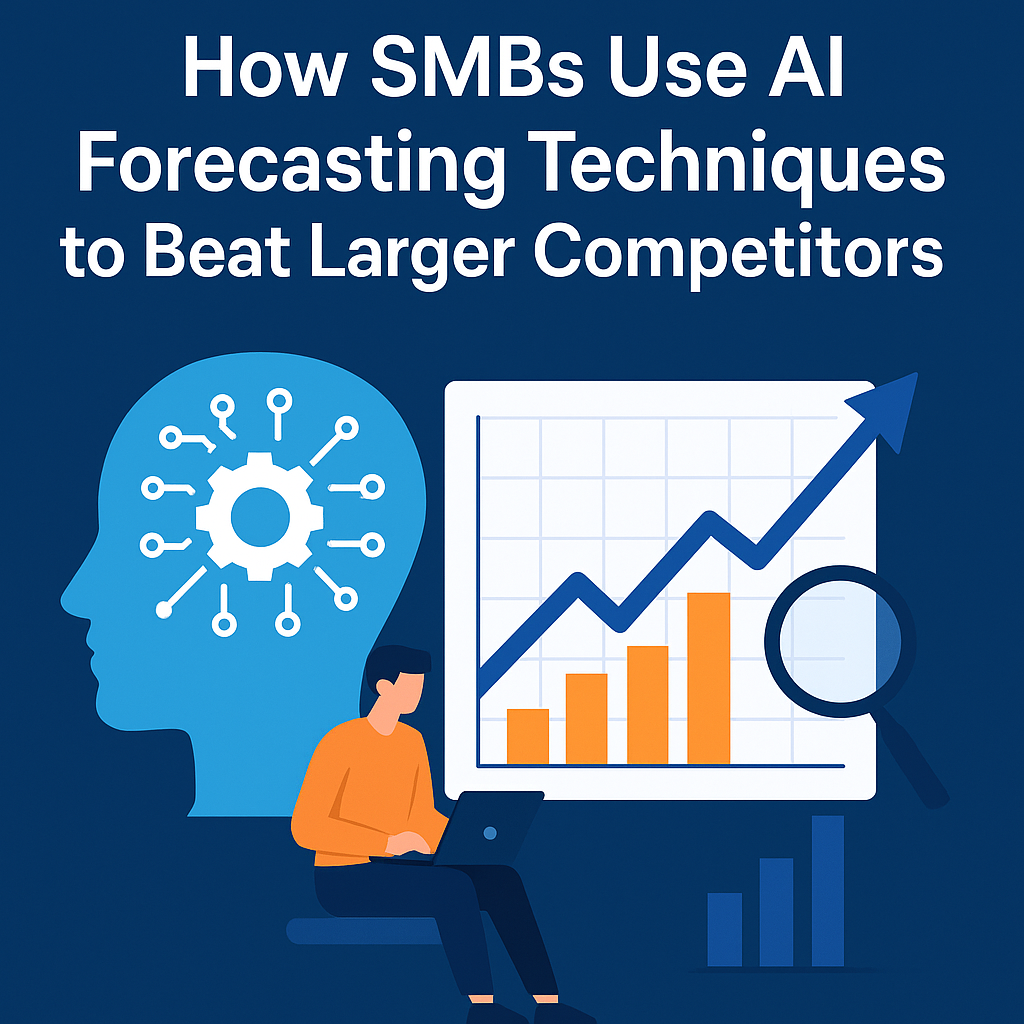Small and mid-sized businesses (SMBs) are often seen as underdogs in markets dominated by enterprise giants. But today, many are leveraging AI-powered forecasting to gain a serious competitive edge—making faster, more precise decisions that help them stay lean, agile, and ahead of the curve.
Here’s how SMBs are using AI forecasting in the real world—and why it’s working.
Forecasting That Keeps Pace with Reality
Old-school forecasting—spreadsheets and quarterly models—isn’t built for modern business velocity. In contrast, AI forecasting taps into real-time data from CRMs, inventory platforms, accounting tools, and even customer behavior analytics.
According to Data Science Central, AI-powered forecasting models can reduce forecast errors by 30–50%, giving SMBs much more accurate insights into demand, cash flow, and growth planning.
Real-World Ways SMBs Are Using AI Forecasting
1. Demand and Inventory Planning
AI forecasting helps businesses avoid stockouts or overstocks by analyzing seasonality, purchasing behavior, and local patterns. A bakery, for instance, might use past trends and event data to predict pastry demand—cutting waste and increasing profits. According to SmartBizly, some SMBs are reducing excess inventory by 10–30% and freeing up working capital in the process.
2. Revenue and Sales Forecasting
By combining historical sales with buyer behavior and lead velocity, SMBs can build smarter, real-time revenue models. A Salesforce report showed 91% of SMBs using AI saw revenue growth, with many doubling down on AI adoption going into 2026.
3. Forecasting Tech Costs
For SaaS and eCommerce companies, cloud costs can spiral without control. AI forecasting tools help predict usage spikes and scale infrastructure accordingly. CriticalCloud offers examples where AI cut monthly costs by anticipating usage and preventing over-deployment.
Forecasting Leads to Efficiency, Not Just Accuracy
Forecasting isn’t just about seeing the future—it’s about running leaner in the present.
- Operational efficiency: AI-based automation can improve team productivity by up to 40%, according to SMB Accelerators.
- Customer support: SMBs using AI chatbots are handling up to 80% of common support questions, reducing support costs by 30–50% while delivering 24/7 coverage. This is especially valuable for solo founders or lean teams (Applied Future).
- Marketing personalization: Tools that track browsing and purchase history can boost average order value by 25% and increase repeat customers by over 35%, also per Applied Future.
How the Technology Works
Behind the scenes, AI forecasting tools often combine multiple models: regression trees, neural networks, ARIMA, exponential smoothing, and more. A study on arXiv found that ensemble forecasting consistently outperformed single-model predictions, especially for SMBs with fluctuating or sparse data.
Today’s best tools also integrate directly with platforms like Shopify, QuickBooks, Salesforce, Stripe, and Google Sheets, making implementation easier than ever.
Common Challenges—and How SMBs Get Around Them
Adoption isn’t frictionless. According to TechRadar Pro, only 12% of SMBs offer AI training, and 52% cite a skills gap as their biggest roadblock.
Still, a New York Post survey found that 75% of SMBs believe AI helps them compete directly with bigger companies—and those who succeed tend to start with narrow use cases like forecasting cash flow, then expand gradually.
How Forecasting Helps SMBs Compete—and Win
Let’s break it down:
- Speed: SMBs can now make strategic decisions in real time instead of reacting after the fact.
- Precision: Lean inventory and accurate demand predictions mean fewer costly mistakes.
- Customer insight: Personalization and behavioral forecasting drive higher lifetime value.
- Cost control: Forecasting cloud usage, labor, and marketing spend gives SMBs tighter margins without big finance teams.
It’s this kind of smart, agile decision-making that lets small firms act fast—while large competitors are still syncing spreadsheets.
Want to See This in Action?
If you want to go deeper, CliqSpot has an excellent piece on how predictive analytics gives small businesses a marketing edge. It includes real-world examples and swipeable templates for making data-backed decisions. And if your forecasting is being sabotaged by messy inputs, check out The Silent ROI Killer, which explores how poor data hygiene quietly destroys growth potential.
Final Word
Forecasting with AI isn’t just a tactical upgrade—it’s a strategic one. For SMBs, it means less guessing, more clarity, and a greater ability to act fast in a competitive world. The barrier to entry is lower than ever, and the upside? Well, it’s measurable.
Want help choosing the right tools or creating your own forecasting stack? Let me know—I’ll walk you through a real-life setup or map out an article for your audience.

Data-driven editor at CliqSpot, transforming raw analytics into actionable growth strategies for modern businesses.

Leave a Reply